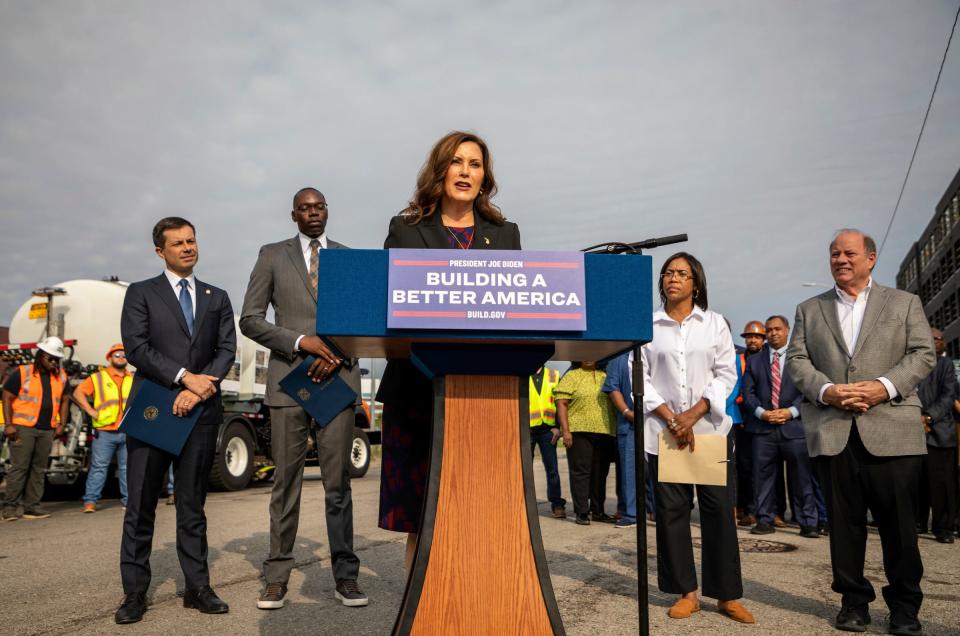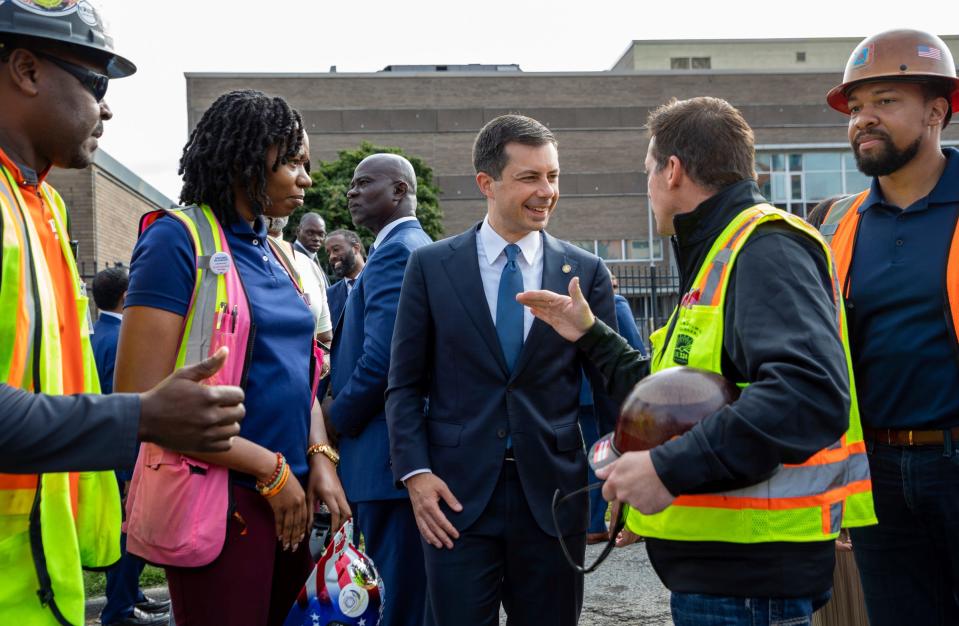Buttigieg: Fixing I-375 means acknowledging those who were displaced to build it
U.S. Transportation Secretary Pete Buttigieg has at times described how racism was built into America’s highway system, with many predominantly minority neighborhoods leveled to make way for the interstates and related infrastructure that dot today's urban landscape.
On Thursday, he echoed that sentiment as he spoke about one of the prominent examples of that process, which played out in Detroit decades ago and still affects the city today, the building of I-375.
That highway and associated “urban renewal” efforts during the past century leveled predominantly African American communities like Black Bottom and Paradise Valley as well as Hastings Street, the commercial corridor that tied so much of the area together.

Buttigieg, standing at a podium on the Chrysler Service Drive just off the highway with city and state officials nearby, had come to announce a nearly $105 million grant that will fund a large chunk of the estimated $270 million effort to remake the approximately 1-mile stretch of highway into a boulevard that will once again be part of the city’s street grid rather than a concrete ditch that serves to divide.
More:MDOT director: Equity, inclusion need to be part of transportation planning
This project snagged a significant share of the total $1.5 billion in grants to 26 projects nationwide announced Thursday by the department. Buttigieg said the competitive nature showcases “the clear and compelling value to the community” that this project and others demonstrate.
“Sometimes, fixing the damn roads means facing the repercussions of how the roads were originally built, who was included in that process and who was not, who was empowered and who was displaced,” Buttigieg said, referencing Gov. Gretchen Whitmer's famous slogan.
Many thousands of people and businesses were displaced when I-375 and the area that now includes Lafayette Park were built, many of whom were renters who received no compensation or relocation assistance at a time when that was particularly difficult for the growing African American population.
More:Feds making $1B available to reconnect communities where highways left their mark
As a symbol, I-375 highlights a past that continues to divide. Mayor Mike Duggan said residents and city officials have had many conversations about this project and know the history.
“I’ve been advocating for six years to fill in this ditch and knit this city back together,” he said. “Detroit’s been divided by this freeway for nearly 70 years. The motivations in wiping out Paradise Valley and Black Bottom in the '50s were well known, but nobody could have imagined the pain that still lasts 70 years later.”
Izegbe N’Namdi, a resident of Lafayette Park who has been involved in the discussions about the future of the I-375 area, said the effort moving forward will help uplift the African American cultural legacy in the city.
“It also allows this area to become the model for the country for the many disenfranchised African American communities that have been affected through the freeway systems,” she said.
More:I-375 replacement project in Detroit moves closer to reality, gets OK from feds
The final design is not yet complete, but the “selected alternative” would see six lanes for much of the route that would begin south of I-75 and end at Atwater Street, adding cycling and pedestrian infrastructure. With the grant funding, construction could begin in 2025, rather than 2027 as had been planned previously. The effort got the green light from the federal government in March, but Michigan Department of Transportation Director Paul Ajegba said the announcement Thursday had special significance, marking “the beginning of the end of the I-375 freeway as we know it today.”
Detroit historian Jamon Jordan is glad that local taxpayers and the state will get some assistance to fund the project, but he wants to know what else the federal government is prepared to do for the area.

The decision to provide the grant “tells us that the federal government is involved in the removal of I-375 just as much as they were involved in the destruction of Hastings Street back in 1959. What we don’t know is if the federal government is as much involved in the building up of African American-owned businesses and the African American community as they were in the destruction of one,” he said. “The freeway is just part of the story.”
The damage done to those adversely affected decades ago — to the many African American businesses that were forced out, for instance — can’t really be undone, he said, but moving forward, a positive outcome is possible if the community has a real say in how the area is rebuilt.
“The community has to be part of the shaping of this policy” and in helping to determine for whom it is builtand which businesses ultimately rise in the reclaimed areas, Jordan said, noting that he would like to see many of those businesses be owned by African Americans.
Contact Eric D. Lawrence: elawrence@freepress.com. Follow him on Twitter: @_ericdlawrence. Become a subscriber.
This article originally appeared on Detroit Free Press: Buttigieg: Fixing I-375, other roads means acknowledging the displaced

